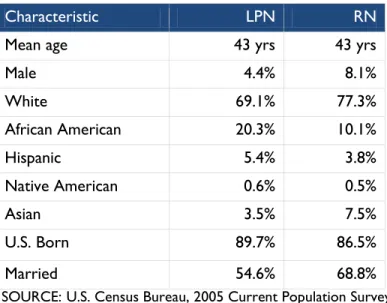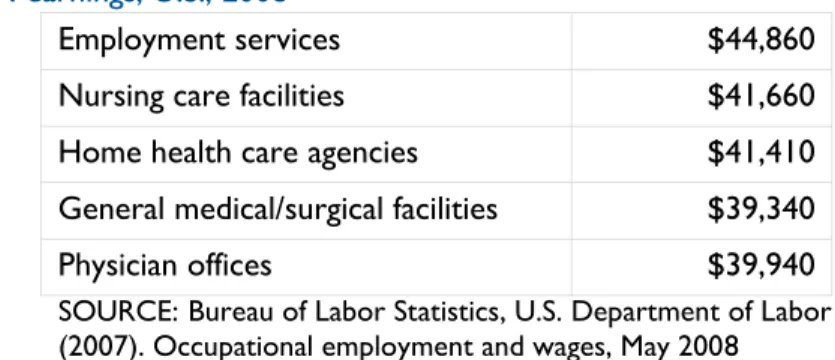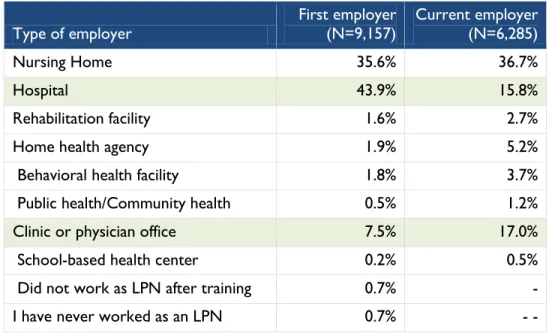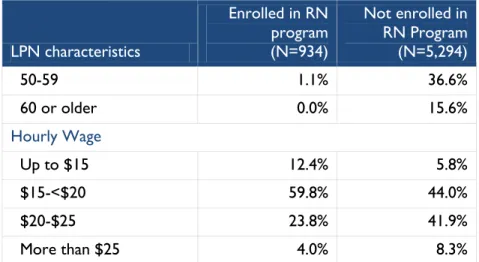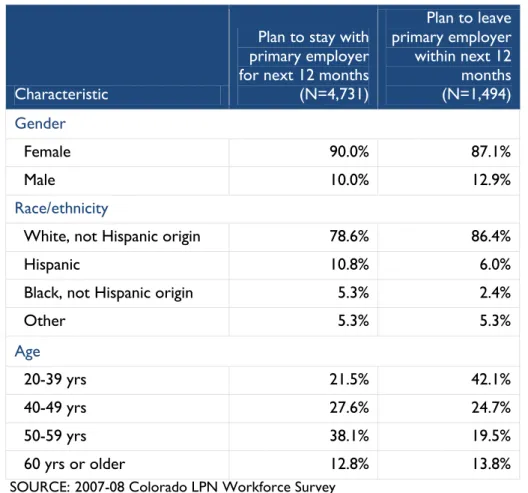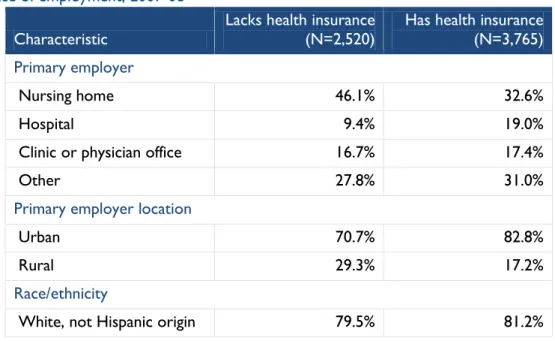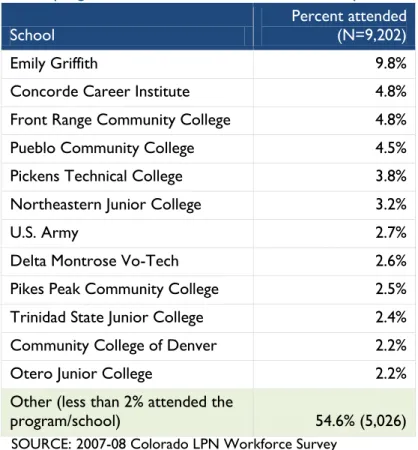Findings
Colorado Health Institute 1576 Sherman Street, Suite 300 Denver, CO 80203-1728 www.coloradohealthinstitute.org
Acknowledgments
The Colorado Health Institute (CHI) wishes to acknowledge the contributions of the Joffit Group, in particular, Cathy Battaglia, PhD, MSHA, RN, and Dana Pepper, RN, MPA, MBA, for the literature review and pre-testing, validation of the survey instrument and analytical support in preparation of the data contained in this report of findings of the 2007 Colorado Licensed Practical Nurse (LPN) Workforce Survey.
CHI staff that supported the development of the report included Rebecca Crepin, research assistant, who completed data entry and preparation of the analytical data file, and Glenn Goodrich and Anna Furniss, SAS programmers and statisticians, who worked with Rebecca to prepare the analytical file. Michael Boyson, director for health information, oversaw the survey design process and survey administration. Pamela Hanes, president and CEO, and Sherry Freeland Walker, communications director, served as technical and style editors, and Kindle Fahlenkamp-Morell, senior communications specialist, was responsible for graphic design.
CHI also would like to thank The Colorado Trust for funding the LPN survey as part of CHI’s Health Professions Database Project.
Finally, CHI would like to acknowledge the substantial contributions of key informants and experts in the field of nursing who reviewed the survey instrument and provided guidance to staff in identifying the policy issues of highest relevance to Colorado policymakers and workforce planners.
Pamela P. Hanes, PhD President and CEO Colorado Health Institute June 2009
Table of Contents
Acknowledgments ... 2
Introduction ... 4
National perspective on the LPN workforce ... 4
Colorado perspective on the LPN workforce ... 6
Colorado LPN workforce initiatives ... 6
Findings from the 2007-08 Colorado LPN Workforce Survey ... 7
Methods ... 7
Demographic profile and employment settings ... 7
Educational pursuits ... 9
Retention and recruitment ... 11
Future plans ... 12
Health insurance coverage ... 14
Level of preparedness for clinical work ... 15
Previous nursing work experience ... 17
Summary of 2007 Colorado LPN Workforce Survey findings ... 17
Workforce Options for Licensed Practical Nurses ... 18
Education and training ... 18
Aspects of the workplace... 18
Data-driven workforce analysis ... 19
Introduction
The Colorado Health Institute (CHI) conducted a survey of licensed practical nurses (LPN) in 2007-08 to increase the body of knowledge regarding the LPN workforce in Colorado and to provide a baseline for future study. From task force discussions, key informant interviews and an extensive literature review, a number of LPN workforce policy questions and issues emerged that informed the survey process:
What is the optimum role of LPN in today’s health care delivery system?
How prepared are LPNs for their first nursing position?
Is there a relationship between previous nursing experience and performance as an LPN and resulting career perceptions?
What factors affect LPN retention in the health care workforce?
What are LPNs’ perceptions of their work environment, including job satisfaction?
The LPN workforce survey instrument was cognitively tested both individually and in focus groups. LPNs participating in the survey testing process worked in long-term care, acute care and out-patient clinic settings in both rural and urban areas.
Limited workforce studies specific to the LPN workforce either nationally or in Colorado existed when this survey was conducted. The most comprehensive study available was carried out by the federal Health Resources and Services Administration and published in 2004. The Colorado Department of Regulatory Agencies (DORA) provides limited data on the LPN workforce based on information LPNs provide during the professional licensure process. To CHI’s knowledge, this workforce survey is the first to be conducted of LPNs employed in Colorado.
NATIONAL PERSPECTIVE ON THE LPN WORKFORCE
Approximately 749,000 LPNs were employed in the United States in 2006. Work settings included hospitals (26%), nursing homes (26%), physician offices/clinics (12%) and other settings (36%) such as community care facilities, nursing agencies, residential care facilities and government agencies. Approximately 19 percent of these LPNs were employed part time.1
Over the past 20 years, the percentage of LPNs working in hospitals has steadily decreased, declining from 54 percent in 1984 to 24 percent in 2005.2 Hospital informants offer a mixed report about the scope of practice of LPNs in acute care settings, reporting that the scope is often too narrow for the acuity of patients while at the same time recognizing that LPNs are an asset to the nursing team.3
1 Bureau of Labor Statistics, U.S. Department of Labor. Occupational Outlook Handbook, 2008-09 Edition, “Licensed practical and licensed vocational nurses.” Available at http://www.bls.gov/oco/ocos102.htm.
2 Lafer, G., and H. Moss (2007). The LPN: A Practical Way to Alleviate the Nursing Shortage. Labor Education and Research Center, University of Oregon, for the United Nurses of America. Available at:
http://www.afscme.org/docs/LPN-Rep.pdf. Also, Spector, N. (2005). Practical Nurse Scope of Practice White Paper. National Council of State Boards of Nursing. Available at:
https://www.ncsbn.org/Final_11_05_Practical_Nurse_Scope_Practice_White_Paper.pdf.
3 Spector, N. (2005). Practical Nurse Scope of Practice White Paper. National Council of State Boards of Nursing. Available at: https://www.ncsbn.org/Final_11_05_Practical_Nurse_Scope_Practice_White_Paper.pdf.
In spite of declining demand for LPNs in acute care settings, the employment of LPNs is projected to grow due to the aging of both the workforce and the population. The largest job growth is projected for nursing care facilities and home health care agencies.4
State boards of nursing regulate LPN practice, and although most states have similar practice statutes, some states are more restrictive in the LPN scope of practice. The American Nurses Association differentiates registered nurses (RNs) from LPNs by RNs’ ability to diagnose and treat human responses to actual or potential health problems—assessment therefore is a key boundary between RN practice and that of LPNs and nurse assistants.5
Table 1. Comparison of LPN and RN workforce, U.S., 20056
Characteristic LPN RN
Mean age 43 yrs 43 yrs
Male 4.4% 8.1% White 69.1% 77.3% African American 20.3% 10.1% Hispanic 5.4% 3.8% Native American 0.6% 0.5% Asian 3.5% 7.5% U.S. Born 89.7% 86.5% Married 54.6% 68.8%
SOURCE: U.S. Census Bureau, 2005 Current Population Survey
In 2006, Colorado ranked 46th among states in the per-capita employment of LPNs with 138 per 100,000 population compared to the national rate of 241 per 100,000.7
The median annual income of LPNs nationally in 2008 was $40,110.8 LPNs tend to earn more with experience, but at some point the salary ranges become compressed. Also, LPN earnings vary by employment sector, with the highest earnings reported by LPNs working in employment services such as temporary positions and home health care agencies.
4 Bureau of Labor Statistics.
5 National Center for Health Workforce Analysis, Health Resources and Services Administration, U.S. Department of Health and Human Services (2004). Supply, Demand and Use of Licensed Practical Nurses, Chapter 3: “Scope of practice and practice acts.” Available at: http://bhpr.hrsa.gov/healthworkforce/reports/lpn/LPN1_5.htm#c3. 6 Seago J., et al. (2006). “Can the use of LPNs alleviate the nursing shortage?” American Journal of Nursing, 106(7):40-49, 2006. Available at: http://www.nursingcenter.com/prodev/ce_article.asp?tid=650968.
7 National Center for Health Workforce Analysis, Health Resources and Services Administration, U.S. Department of Health and Human Services. The Colorado Health Workforce: Highlights from the Health Workforce Profile. Available at: http://bhpr.hrsa.gov/healthworkforce/reports/statesummaries/colorado.htm.
8 Bureau of Labor Statistics, U.S. Department of Labor (2007). Occupational employment and wages, May 2008, Licensed practical and licensed vocational nurses. Available at: http://www.bls.gov/oes/current/oes292061.htm.
Table 2. LPN earnings, U.S., 2008
Employment services $44,860
Nursing care facilities $41,660
Home health care agencies $41,410
General medical/surgical facilities $39,340
Physician offices $39,940
SOURCE: Bureau of Labor Statistics, U.S. Department of Labor (2007). Occupational employment and wages, May 2008
COLORADO PERSPECTIVE ON THE LPN WORKFORCE
The scope of practice for an LPN in Colorado is defined in the Colorado Nurse Practice Act “as that which is taught in schools of practical nursing in Colorado at this time.”9 Colorado currently has 26 LPN programs10 including one baccalaureate and two associate degree nursing programs with a practical nursing exit option. The 9-11 month curriculum trains LPNs to care for patients with “predictable outcomes” and perform nursing skills “with a high degree of technical expertise.” LPNs are taught to identify abnormal functions and changes in a patient's condition and to report their findings to a physician or registered nurse to do a full assessment.11
The Colorado Department of Regulatory Agencies (DORA) reports that Colorado had 8,576 active licensed LPNs in FY2008.12 In 2008 the average earnings of Colorado’s LPN workforce were $40,870, with a mean hourly rate of $19.65.13
Colorado LPN workforce initiatives
The Colorado Center for Nursing Excellence has been involved in a number of initiatives to enhance LPN training and facilitate their transition from LPN to RN licensure.14
The Central Colorado Area Health Education Center (AHEC) offers an online refresher course for LPN/LVNs who desire to re-activate their license.15
9 Colorado Department of Regulatory Agencies (DORA), Board of Nursing (2009). “Scope of practice for the licensed practical nurse.” Available at http://www.dora.state.co.us/NURSING/scope/scope.htm.
10 DORA, Board of Nursing (2009). “Approved practical nursing programs.” Available at: http://www.dora.state.co.us/NURSING/education/LPNprograms.pdf.
11 DORA. “Scope of practice.” For more information on nursing education programs in Colorado, see DORA, Division of Registrations, Board of Nursing. “Chapter II-Rules and Regulations for Approval of Nursing Education Programs.” Board Rule II, § 3.13 C.5.a. Available at: http://www.dora.state.co.us/nursing/rules/ChapterII.pdf. 12 DORA, Office of Policy, Research and Regulatory Reform (2008). 2008 Sunset Review: Colorado Board of Nursing. Available at: http://www.dora.state.co.us/opr/archive/2008Nursing.pdf.
13 Bureau of Labor Statistics, U.S. Department of Labor (2008). Occupational employment statistics, May 2008, State Occupational Employment and Wage Estimates, Colorado. Available at:
http://www.bls.gov/oes/2008/may/oes_co.htm#b29-0000.
14 Colorado Center for Nursing Excellence (2008). Colorado nursing workforce development programs data. Retrieved November 15, 2008, from:
http://www.coloradonursingcenter.org/CurrentProjects/CurrentProjectsPrograms.html. 15 Central Colorado Area Health Education Center (AHEC). Retrieved November 1, 2008, from http://www.centralcoahec.org/lpnrefresher.htm.
Mesa State College received funding from the Colorado Department of Labor and Employment to enable LPNs to earn an associate degree in nursing. Currently, Mesa State has the only program in Colorado that encourages students to obtain an entry-level certificate, enter the workforce and then return to get an associate of applied science degree in nursing within three years without reapplying.16
An LPN nursing skills lab at the Pickens Technical School and Community College of Aurora helps increase LPN competencies and provide a health career Web site for staff and employers. The project is funded by the Colorado Department of Labor and Employment.17
Kaiser Permanente and the Colorado Department of Labor and Employment have developed a program to assist 19 medical assistants in becoming LPNs at the Community College of
Denver.18
Findings from the 2007-08 Colorado LPN Workforce Survey
METHODS
On November 24, 2007, the Colorado Health Institute (CHI) sent 2,500 cover letters and survey questionnaires to a stratified random sample of individuals who held an active license to practice as a licensed practical nurse (LPN) in Colorado. This sample was selected from LPNs who had a Colorado contact address (N=9,719) in their licensure file maintained by the Colorado Department of Regulatory Agencies. Accounting for undeliverable mail, out-of-state addresses and/or deceased persons, the number of LPNs presumed to have received the form was 2,393. CHI received survey responses from 1,002 LPNs, or about 42 percent of those who were mailed a survey form.
All male LPNs with a rural Colorado address were surveyed to ensure an adequate rural sample for analytical purposes. A random sample was taken of the remaining LPNs. CHI then added “weights” to the survey data to reduce any bias created by the design of the sample and to bring the sample back to the total population of licensed LPNs. The percentages and numbers used in this report are therefore reflective of the entire population of licensed Colorado LPNs, not just the survey respondents. [For more information on the methods used in conducting this survey and analyzing the findings, please see http://www.coloradohealthinstitute.org/Documents/workforce/2007LPNCodebook.pdf.]
DEMOGRAPHIC PROFILE AND EMPLOYMENT SETTINGS
In 2007, Colorado LPNs were predominately female, white and working in an urban setting. The majority was 40 years of age or older (77%) and most likely to be employed in a long-term care setting.
16 Mesa State College Nursing Education Career Ladder. Retrieved March 31, 2009, from http://www.mesastate.edu/healthsciences/ladder.html.
17 Colorado Center for Nursing Excellence. 18 Colorado Center for Nursing Excellence.
Table 3: Profile of Colorado LPNs, 2007-08
Female 90.6%
(N=8,453) Male 9.4% (N=877) Mean age 48
Work setting of licensed LPNs, 2007-08 Race and ethnicity of licensed LPNs, 2007-08
SOURCE: 2007-08 Colorado Licensed Practical Nurse Workforce Survey
The majority of licensees (72%) was working as an LPN at the time of the survey and worked on a full-time basis, averaging 37 hours per week. Approximately 85 percent reported earnings between $15 and $20 per hour, which was consistent with the U.S. Bureau of Labor Statistics reported mean wages of $19 in 2008.
In the United States and Colorado, more medical care is currently provided in outpatient settings than in hospitals. In general, the sickest and most complex patients are admitted to hospitals where higher skill levels, education and a broader scope of nursing practice are required. The 2007-08 LPN survey findings reveal that 28 percent fewer LPNs were working in hospitals at the time of the survey as opposed to the first job they held after graduation.
Table 4. Place of LPN employment compared to first employer after graduation, 2007-08
Type of employer First employer (N=9,157) Current employer (N=6,285)
Nursing Home 35.6% 36.7%
Hospital 43.9% 15.8%
Rehabilitation facility 1.6% 2.7%
Home health agency 1.9% 5.2%
Behavioral health facility 1.8% 3.7%
Public health/Community health 0.5% 1.2%
Clinic or physician office 7.5% 17.0%
School-based health center 0.2% 0.5%
Did not work as LPN after training 0.7% -
Type of employer First employer (N=9,157) Current employer (N=6,285)
Correctional facility 0.0% 3.3%
Assisted living facility 0.0% 3.0%
Nursing agency 0.0% 2.6%
Other 5.6% 8.3%
Shaded cells highlight significant differences between first and current employers. SOURCE: 2007-08 Colorado LPN Workforce Survey
LPNs who were not working in a clinical position in 2007-08 (N=2,940) provided the following reasons:
Working in an administrative/other health care-related position (39%);
Voluntarily unemployed and not actively seeking employment (11%);
Voluntarily unemployed due to family responsibilities (10%); and,
Unemployed and actively looking for clinical LPN position (7%).
Approximately 16 percent (1,009) of LPNs reported having a second employer. Of LPNs with a second employer, the factors that were important in this decision included:
64% didn’t earn enough at their primary place of employment;
50% wanted more challenging work;
33% didn’t get health insurance at their primary place of employment; and,
32% didn’t have enough hours at their primary place of employment. EDUCATIONAL PURSUITS
Few LPNs were pursuing further education and most had no plans to do so. Specifically:
Only 4.6% were enrolled in another type of educational program;
15% were currently enrolled in an RN education program; and,
62.9% reported that they did not plan to pursue an RN degree.
Table 5. Characteristics of LPNs enrolled and not enrolled in an RN program, 2007 LPN characteristics Enrolled in RN program (N=934) Not enrolled in RN Program (N=5,294) Primary Employer Nursing home 37.7% 37.4% Hospital 34.4% 1.3%
Clinic or Physician office 9.7% 18.9%
Other 18.2% 31.4%
Current Age
20-39 51.2% 22.5%
LPN characteristics Enrolled in RN program (N=934) Not enrolled in RN Program (N=5,294) 50-59 1.1% 36.6% 60 or older 0.0% 15.6% Hourly Wage Up to $15 12.4% 5.8% $15-<$20 59.8% 44.0% $20-$25 23.8% 41.9% More than $25 4.0% 8.3%
SOURCE: 2007-08 Colorado Licensed LPN Workforce Survey
The Colorado LPNs enrolled in an RN program in 2007-08 had the following profile:
38% worked in a nursing home and 34% in a hospital setting;
All but one were between the ages of 20 and 49; and,
The vast majority earned less than $20 an hour.
The most common reasons cited for not pursuing additional education were:
Could not afford the cost (62%);
Other time commitments took priority (55%); and,
Satisfied with current work and did not need additional education or training (44%). If offered the opportunity, most LPNs (89% of those currently working) indicated they would be
interested in on-the-job training in a variety of clinical areas including wound care, geriatrics, Alzheimer’s disease and other dementias. In 2005, the Centers for Medicare and Medicaid Services (CMS) modified its guidelines for pressure sore care in long-term care facilities and these new guidelines are now reflected in Colorado’s facility survey process. The interest in wound care training is likely related to these guidelines.
Table 6. Training interests of LPNs who were interested in further training, 2007-08
Training interests (N=5,658) Percent*
Wound care 75.3%
Alzheimer’s disease and/or other types of mental
disorders 66.7%
Geriatrics 64.5%
Developmental disabilities and other cognitive
disorders 57.3%
Spinal cord injuries 54.8%
Pediatric long-term care 46.5%
Percentages exceed 100% as respondents could check more than one interest. SOURCE: 2007-08 Colorado LPN Workforce Survey
RETENTION AND RECRUITMENT
The Colorado LPN survey asked about workplace incentives LPNs were currently receiving or had received at their place of employment and their level of importance.
Table 7. Top workplace incentives received and ranking of importance, 2007-08
Workplace incentives (N = 6,225) Percent
Flexible work schedule 49.9%
Tuition reimbursement 21.9%
Signing bonus 9.9%
Student loan forgiveness 1.9%
Ranked of high importance (4-5) on a 5-point scale
Percent (N = 6,225)
Flexible work schedule 89.9%
Tuition reimbursement 72.0%
Signing bonus 61.9%
Student loan forgiveness 56.0%
SOURCE: 2007-08 Colorado LPN Workforce Survey
The majority of LPNs earned between $15 and $25 per hour with little disparity between work settings.
Table 8. LPN wages earned by employment setting, 2007-08 Employment setting Nursing home (N=2,428) (N=1,022) Hospital Clinic/physician office (N=1,086) (N=1,853) Other* Up to $15/hr 2.2% 13.8% 18.4% 4.9% $15.01-$20/hr 32.7% 47.0% 57.6% 49.2% $20.01-$25/hr 53.4% 38.8% 20.0% 36.8% More than $25/hr 11.7% 0.4% 4.0% 9.1%
*Other included corrections, assisted-living facilities, behavioral health. SOURCE: 2007-08 Colorado LPN Workforce Survey
Of Colorado LPNs who were not employed in a clinical position in 2007 (28%), the top three reasons provided were wages, stress and lack of respect.
Table 9. Highest importance* reasons for not working in a clinical position, 2007-08 Reason
Percent (N = 1,950)
Wages insufficient given the workload and responsibility 57.1%
Too much stress on the job 55.9%
Did not feel respected in the work performed 53.3% Insufficient benefits (e.g. sick leave, health insurance) 43.0%
Hours too long 40.7%
Workplace safety issues 34.9%
Inconvenient hours 33.4%
Family responsibilities interfere with work 27.4%
Retired from active workforce 25.2%
No LPN positions available 25.2%
Work not professionally challenging 24.5%
Pursuing more education 23.4%
Health issues 22.7%
*Percentage of LPNs who rated these reasons a 4 or 5 with 5 indicating “most important.”
SOURCE: 2007-08 Colorado LPN Workforce Survey FUTURE PLANS
One-fourth of Colorado LPNs reported that they planned to leave their primary employer within the next 12 months. Characteristics of those who planned to leave and those who intended to stay were quite similar with two exceptions: work setting and age.
Table 10: Comparison of LPNs’ employment plans within next 12 months, 2007-08
Characteristic
Plan to stay with primary employer for next 12 months (N=4,731) Plan to leave primary employer within next 12 months (N=1,494) Primary Employer Nursing home 33.5% 50.2% Hospital 18.1% 8.2%
Clinic or physician office 19.0% 28.3%
Characteristic
Plan to stay with primary employer for next 12 months (N=4,731) Plan to leave primary employer within next 12 months (N=1,494) Gender Female 90.0% 87.1% Male 10.0% 12.9% Race/ethnicity
White, not Hispanic origin 78.6% 86.4%
Hispanic 10.8% 6.0%
Black, not Hispanic origin 5.3% 2.4%
Other 5.3% 5.3% Age 20-39 yrs 21.5% 42.1% 40-49 yrs 27.6% 24.7% 50-59 yrs 38.1% 19.5% 60 yrs or older 12.8% 13.8%
SOURCE: 2007-08 Colorado LPN Workforce Survey
LPNs planning to leave their current employer within the next year ranked the following reasons of high importance (4-5) on a five-point scale:
Table 11. Reasons LPNs report planning to leave their employer in next 12 months,* 2007-08 Reasons for planning to leave employer in next 12 months (N = 1,494) Percent
Too much stress on the job 70.1%
The wages are insufficient given the workload and
responsibility 69.2%
I do not feel respected in the work I do as an LPN 66.2% Insufficient benefits (e.g. sick leave, health insurance) 52.0%
I am pursuing more education 46.4%
Workplace safety issues 46.1%
I do not feel the work is professionally challenging 41.5%
The hours are inconvenient 32.6%
The hours are too long 29.9%
Reasons for planning to leave employer in next 12 months (N = 1,494) Percent
I am retiring from the active workforce 15.8%
I have family responsibilities that interfere with my ability to
work as an LPN 11.3%
*Percentage of LPNs who rated these reasons a 4 or 5 with 5 indicating “most important.” SOURCE: 2007-08 Colorado LPN Workforce Survey
HEALTH INSURANCE COVERAGE
Approximately 60 percent of LPNs working at the time of the survey reported having health insurance coverage through their primary employer. Of the 40 percent that did not have coverage, 69 percent (1,690) were offered it and declined.
Table 12. Reasons given by Colorado LPNs who were offered but declined health insurance coverage,* 2007-08
Reasons % (N=1,527)
Coverage from a spouse or other family member 66.9%)
Coverage offered was too expensive 62.9%
Did not need health insurance at the time 25.9%
Health insurance coverage not a high priority 29.0%
Coverage that was offered did not meet my health care needs 29.0% NOTE: *Percentage of LPNs who rated these factors a 4 or 5 with 5 indicating “very important.” SOURCE: 2007-08 Colorado LPN Workforce Survey
Table 13. Characteristics of LPNs who did and did not have health insurance through primary place of employment, 2007-08
Characteristic Lacks health insurance (N=2,520) Has health insurance (N=3,765)
Primary employer
Nursing home 46.1% 32.6%
Hospital 9.4% 19.0%
Clinic or physician office 16.7% 17.4%
Other 27.8% 31.0%
Primary employer location
Urban 70.7% 82.8%
Rural 29.3% 17.2%
Race/ethnicity
Characteristic Lacks health insurance (N=2,520) Has health insurance (N=3,765)
Hispanic 8.6% 9.8%
Black, not Hispanic origin 5.3% 4.5%
Other 6.6% 4.5% Age 20-39 yrs 30.9% 23.4% 40-49 yrs 31.3% 22.7% 50-59 yrs 25.4% 40.1% 60 yrs or older 12.4% 13.8%
SOURCE: 2007-08 Colorado LPN Workforce Survey LEVEL OF PREPAREDNESS FOR CLINICAL WORK
The survey provides a snapshot of LPNs’ self-assessed educational preparation. Both classroom and clinical experiences were described and reveal significant relationships between level of readiness and the following factors:
LPN training program
Type of school where program was offered, e.g., college, vocational/technical school, military
Year of graduation
Place of instruction (clinical or classroom)
Location of training program (rural or urban)
Prior health care experience
Rating of classroom and clinical instruction
LPNs rated their classroom and clinical instruction using a five-point scale in which 1 represented “inadequate” and 5 “most adequate.” The components of the educational experience measured were:
Care for the elderly
Care for persons with dementia and other mental impairments
Care for persons with physical disabilities
Care for persons with behavioral health problems
Administration of medications
Patient care fundamentals, such as bathing, personal care, transferring and inserting catheters
Decision-making within the LPN scope of practice
Leadership/management skills
Problem-solving skills
Table 14: Schools or programs where LPNs received their LPN diplomas, 2007-08
School Percent attended (N=9,202)
Emily Griffith 9.8%
Concorde Career Institute 4.8%
Front Range Community College 4.8%
Pueblo Community College 4.5%
Pickens Technical College 3.8%
Northeastern Junior College 3.2%
U.S. Army 2.7%
Delta Montrose Vo-Tech 2.6%
Pikes Peak Community College 2.5%
Trinidad State Junior College 2.4%
Community College of Denver 2.2%
Otero Junior College 2.2%
Other (less than 2% attended the
program/school) 54.6% (5,026)
SOURCE: 2007-08 Colorado LPN Workforce Survey
Table 15. Percent of LPNs by graduation year who rated their preparation positively, 2007-08*
Year Percent attending (N=8,851)
1950-69 85.5% 1970-79 77.6% 1980-89 79.8% 1990-99 67.0% 2000-07 63.9% OVERALL 72.8%
*Percentage of LPNs who rated their clinical and classroom preparation a 4 or 5 with 5 indicating “most adequate.” SOURCE: 2007-08 Colorado LPN Workforce Survey
Linking the level of preparation to the year of graduation provides an interesting comparison and insight into possible curriculum changes that have occurred over time. The downward trend in perceptions of preparedness for first LPN position was significant and would require additional scrutiny to determine causation.
PREVIOUS NURSING WORK EXPERIENCE
Approximately 60 percent of LPNs had prior health care experience before becoming an LPN. Of those, 89 percent were nurse assistants, the remaining were either medical assistants or emergency medical assistants.
Interestingly, LPNs with prior experience did not rate their level of preparation for their first position significantly different than those without prior health care experience.
SUMMARY OF 2007-08COLORADO LPNWORKFORCE SURVEY FINDINGS Rural and urban distinctions were not evident in the survey findings
A greater percentage of Colorado’s LPNs worked in a long-term care setting in 2007-08 (36%) than LPNs nationally (26%).
The number of LPNs enrolled in an RN program was 15% and little data exist to compare regionally or nationally.
The number of LPNs pursuing any additional education (4.6%) was quite low, although half indicated interest. This finding suggests an opportunity for employers and educators to collaborate in increasing the skills of the LPN workforce with possible positive impacts on the quality of patient care, job satisfaction and subsequent job retention.
The key findings of LPNs’ rating of their educational preparation were:
No significant differences were found between LPN programs located in rural versus urban areas;
Significant differences were noted between individual programs; The U.S. Army programs had the highest ratings;
Of the 12 Colorado LPN programs identified, one in three was rated adequate/most adequate less than 60% of the time; and
LPNs felt least prepared for practice in caring for people with dementia, physical disabilities and behavioral health problems; and in developing leadership and management skills.
The level of preparedness reported by LPNs for their first position offers insight for employers and educators:
With regard to curriculum content, LPNs gave the lowest ratings to areas critical for practice in long-term care settings including assisting people with mental impairments, physical disabilities and behavioral health problems.
LPNs reported declining levels of preparation over time, with LPNs graduating between 1950 and 1969 rating their overall preparation (86%) higher than those who graduated in the past 17 years (64-67%).
LPNs employed in settings other than a hospital were typically placed in leadership roles as a care team leader or charge nurse, meaning management skills are important to being successful on the job.
Workforce Options for Licensed Practical Nurses
EDUCATION AND TRAINING
An opportunity exists for employers and educators to develop continuing education programs for LPNs. The LPN workforce survey findings indicate LPNs are interested in continuing education but actual participation is low. The specific areas of both interest and need determined through research and survey findings are:
Caring for persons with dementia
Caring for persons with physical disabilities
Caring for persons with behavioral health problems Development of leadership and management skills
Caring for persons at risk for wounds or who have developed wounds
The 2007 Colorado LPN Workforce Survey identified specific information about LPNs’ satisfaction with their level of preparedness for their first LPN position. This information links specific areas of learning with the Colorado LPN program attended, and should be reviewed and evaluated by educators [available upon request].
ASPECTS OF THE WORKPLACE
LPNs indicated that a supportive and respectful work environment was an important factor in job retention and satisfaction. Options for consideration to both improve and maintain such a work environment for LPNs include:
Sponsored workshops on topics of interest to LPNs such as care delivery; enhancements, use of new care products and improving medication administration methods; and,
Increase education and training regarding leadership and time management to improve the LPN approach to their work.
The use of multidisciplinary care teams should be considered for further development. The LPN role could be optimized in the care team, leading to improved care delivery, a decrease in the need for as many registered nurses (RNs) and increased job satisfaction for LPNs.
Employers should evaluate the LPN and RN scope of practice on a regular basis to determine if LPNs are being more constrained in their practice roles than required. This step could result in an expansion of the role or an increased awareness of LPN responsibilities.
LPNs should be encouraged to seek additional training and certification in intravenous
medication administration, wound care and other clinical areas as available. This improvement can be accomplished through on-site courses, employer reimbursement and increased
compensation for additional certifications and would add to LPNs’ ability to provide more comprehensive care to their patients.
Employers of LPNs should compare the workforce survey and research findings with their internal survey results, employee feedback and their own observations. Of particular interest to employers may be the transition of certified nurse aides to the LPN role and strategies to foster this development and thus add to their LPN workforce.
Employers of LPNs should strive for cultural competency in recruitment and retention strategies. The ethnicity of the LPN workforce in Colorado is predominately White (80%), which is representative of the state’s ethnic composition (82%). An opportunity may exist,
however, for outreach to other racial and ethnic groups to join the LPN workforce through focused strategies.
DATA-DRIVEN WORKFORCE ANALYSIS
This LPN workforce survey project adds to a limited body of knowledge about LPNs in Colorado and forms a basis for future comparisons that monitor trends, identifies issues and challenges myths or assumptions that have been made about LPNs. Additional surveys and studies of this workforce would be important to recognize important changes as they evolve and to modify or develop strategies as appropriate.
PROFESSIONAL DEVELOPMENT AND RECOGNITION OF LPNS
LPNs represent 15 percent of Colorado’s nursing workforce as indicated below while experiencing a slight decline in numbers between 2003-04 and 2005-06. This decline should be monitored closely as the projected demand for long-term care nursing staff in the state and the nation is growing. The Bureau of Labor Statistics (BLS) has projected a 14 percent increase in demand for LPNs nationally from 2000-16.19 According to estimates developed by the U.S. Department of Health and Human Services’ Office of the Assistant Secretary for Planning and Evaluation, the demand for direct care workers in long-term care settings, which includes LPNs, will become even greater as the baby boomers reach age 85 beginning in 2030.
Table 16: Total number of Colorado nurse licensees, 2003-0720
Year
Total number of active licensed
nurses Number of active RNs active LPNs Number of
2006
53,480
43,805
9,675
2007
54,235
45,507
8,728
2008
56,950
47,100
9,850
2009
57,481
48,905
8,576
SOURCE: Colorado Department of Regulatory Agencies, Division of Registration
Recruitment and retention strategies for the LPN workforce often take a “backseat” to those used to promote the recruitment of RNs. A key issue in the nursing workforce is to critically examine the LPN role both now and in the future in Colorado and subsequently increase the visibility of LPN training and workforce deployment through public education and policy development. To this point, only a small number of LPNs (15%) responding to the survey were currently enrolled in an RN program. This finding is consistent with national trends which describe the barriers to LPN career ladders to RN licensure as:21
Initial salary decreases experienced once LPNs advance to RN status;
19 Bureau of Labor Statistics, U.S. Department of Labor. Occupational Outlook Handbook, 2008-09 Edition, “Licensed practical and licensed vocational nurses.” Available at http://www.bls.gov/oco/ocos102.htm.
20 DORA, Office of Policy, Research and Regulatory Reform (2008). 2008 Sunset Review: Colorado Board of Nursing. Available at http://www.dora.state.co.us/opr/archive/2008Nursing.pdf.
The cost of pursuing an RN education—tuition, child care, loss of work while pursuing education and related costs such as travel and supplies; and,
The wait times experienced to enroll in an RN program.
The advancement of LPNs to RNs may be encouraged through increasing scholarships that provide funds for both tuition and related educations costs such as child care.
The initial salary decreases experienced when an LPN advances to RN status is less dramatic for LPNs who have been in the workforce for a shorter period of time. It may be effective to target the newer LPNs for recruitment into RN programs by contacting them during their LPN education.
